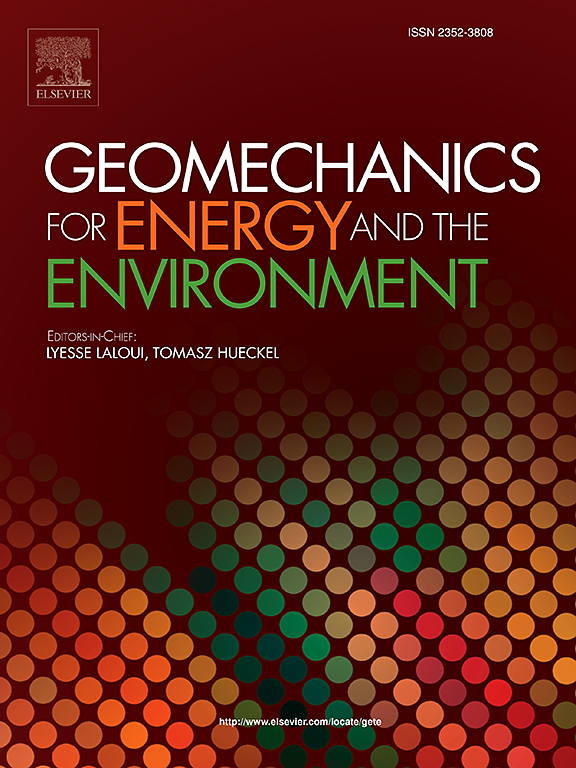Numerical simulation of coupled THM behaviour of full-scale EBS in backfilled experimental gallery in the Horonobe URL
IF 3.7
2区 工程技术
Q3 ENERGY & FUELS
引用次数: 0
Abstract
Bentonite-based engineered barrier system (EBS) is a key component of many repository designs for the geological disposal of high-level radioactive waste. Given the complexity and interaction of the phenomena affecting the barrier system, coupled thermo-hydro-mechanical (THM) numerical analyses are a potentially useful tool for a better understanding of their behaviour. In this context, a Task (the Horonobe EBS experiment) was undertaken to study, using numerical analyses, the thermo-hydro-mechanical (and thermo-hydro) interactions in bentonite based engineered barriers within the international cooperative project DECOVALEX 2023. One full-scale in-situ experiment and four laboratory experiments, largely complementary, were selected for modelling. The Horonobe EBS experiment is a temperature-controlled non-isothermal experiment combined with artificial groundwater injection. The Horonobe EBS experiment consists of the heating and cooling phases. Six research teams performed the THM or TH (depended on research team approach) numerical analyses using a variety of computer codes, formulations and constitutive laws. For each experiment, the basic features of the analyses are described and the comparison between calculations and laboratory experiments and field observations are presented and discussed.
对 Horonobe URL 回填实验走廊中全尺寸 EBS 的耦合 THM 行为进行数值模拟
基于膨润土的工程屏障系统(EBS)是许多高放射性废物地质处置库设计的关键组成部分。鉴于影响屏障系统的各种现象的复杂性和相互作用,热-水-机械(THM)耦合数值分析是更好地了解其行为的潜在有用工具。在此背景下,在 DECOVALEX 2023 国际合作项目范围内开展了一项任务(Horonobe EBS 实验),利用数值分析研究基于膨润土的工程屏障中的热-水-机械(和热-水)相互作用。我们选择了一个全面的现场实验和四个实验室实验进行建模,这些实验在很大程度上是互补的。Horonobe EBS 实验是一项温控非等温实验,结合了人工地下水注入。Horonobe EBS 实验包括加热和冷却两个阶段。六个研究小组利用各种计算机代码、公式和构成法则进行了 THM 或 TH(取决于研究小组的方法)数值分析。对于每个实验,都描述了分析的基本特征,并介绍和讨论了计算与实验室实验和现场观测之间的比较。
本文章由计算机程序翻译,如有差异,请以英文原文为准。
求助全文
约1分钟内获得全文
求助全文
来源期刊

Geomechanics for Energy and the Environment
Earth and Planetary Sciences-Geotechnical Engineering and Engineering Geology
CiteScore
5.90
自引率
11.80%
发文量
87
期刊介绍:
The aim of the Journal is to publish research results of the highest quality and of lasting importance on the subject of geomechanics, with the focus on applications to geological energy production and storage, and the interaction of soils and rocks with the natural and engineered environment. Special attention is given to concepts and developments of new energy geotechnologies that comprise intrinsic mechanisms protecting the environment against a potential engineering induced damage, hence warranting sustainable usage of energy resources.
The scope of the journal is broad, including fundamental concepts in geomechanics and mechanics of porous media, the experiments and analysis of novel phenomena and applications. Of special interest are issues resulting from coupling of particular physics, chemistry and biology of external forcings, as well as of pore fluid/gas and minerals to the solid mechanics of the medium skeleton and pore fluid mechanics. The multi-scale and inter-scale interactions between the phenomena and the behavior representations are also of particular interest. Contributions to general theoretical approach to these issues, but of potential reference to geomechanics in its context of energy and the environment are also most welcome.
 求助内容:
求助内容: 应助结果提醒方式:
应助结果提醒方式:


